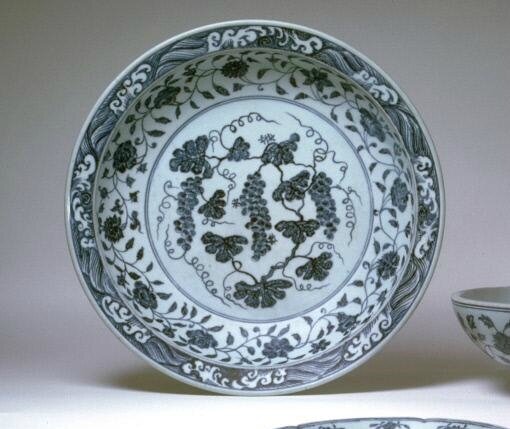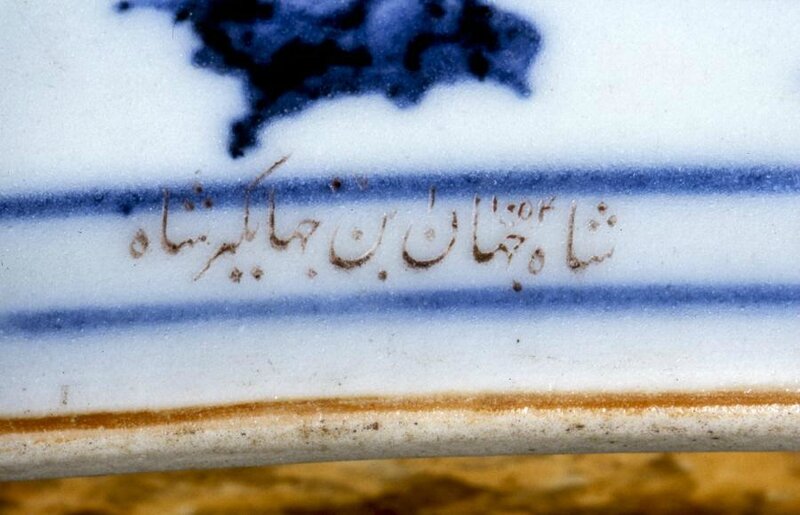Plate with grape design, Ming dynasty (1368-1644), Reign of the Xuande emperor (1426-1435)
Plate with grape design, Ming dynasty (1368-1644), Reign of the Xuande emperor (1426-1435), China, Jiangxi province. Porcelain with underglaze-blue decoration, qinghua ware. H. 3 in x Diam. 14 3/4 in, H. 7.6 cm x Diam. 37.5 cm. The Avery Brundage Collection, B65P6. © 2016 Asian Art Museum Chong-Moon Lee Center for Asian Art and Culture
An inscription on the foot of this plate indicates that it once belonged to the Mughal emperor Shah Jahan (reigned 1628-1658). Although numerous foreign luxury items were amassed by the Mughals, few Chinese porcelains can be linked definitively with them.
© 2016 Asian Art Museum Chong-Moon Lee Center for Asian Art and Culture
The designs on the vessel—three grape clusters encircled by twelve flowers and a border of waves—are among the decorative motifs associated with fifteenth-century Chinese blue-and-white porcelains. Production of these wares appears to have been especially stimulated by foreign demand. Apart from the Mughal emperors, the Ottoman sultans and the Persian Safavid shahs also prized Chinese porcelains. Their extensive royal collections were preserved, respectively, in the Topkapi Palace (Istanbul, Turkey) and in the Safavid dynastic shrine (Ardebil, Iran). The appeal of Chinese blue-and-white wares to all of these Muslim rulers lay in the wares' visual beauty and relative scarcity as well as in the belief that their color would change if touched by poison.

/https%3A%2F%2Fprofilepics.canalblog.com%2Fprofilepics%2F1%2F0%2F100183.jpg)
/https%3A%2F%2Fstorage.canalblog.com%2F03%2F02%2F119589%2F96711876_o.jpg)
/https%3A%2F%2Fstorage.canalblog.com%2F11%2F31%2F119589%2F94773502_o.jpg)
/https%3A%2F%2Fstorage.canalblog.com%2F20%2F83%2F119589%2F94772815_o.jpg)
/https%3A%2F%2Fstorage.canalblog.com%2F26%2F72%2F119589%2F75604929_o.jpg)
/https%3A%2F%2Fstorage.canalblog.com%2F59%2F60%2F119589%2F26458628_o.jpg)




/image%2F1371349%2F20240426%2Fob_9bd94f_440340918-1658263111610368-58180761217.jpg)
/image%2F1371349%2F20240426%2Fob_844371_440162278-1658267648276581-39734064969.jpg)
/image%2F1371349%2F20240425%2Fob_78c699_440320998-1657454638357882-17494889713.jpg)
/image%2F1371349%2F20240421%2Fob_1dddd2_438878301-1654314112005268-81048289869.jpg)